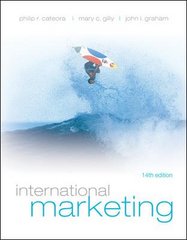Question
1.Which of the following must be true for a good for which there is demand and a limited supply? (2 points) The good has no

1.Which of the following must be true for a good for which there is demand and a limited supply? (2 points)
The good has no utility.
The good's producer enjoys a comparative advantage.
Most consumers will find the good their optimal choice.
The good is scarce.
The production of the good will have a constant opportunity cost.
2.
Why might a food item such as bread not necessarily be a consumer good in all economic scenarios? (2 points)
Food products are scarce.
It could be sold to a government employee.
It could be an ingredient in a consumer good that is sold by a business.
Acquiring one food item involves not acquiring another item that could have been purchased instead.
Since food is consumed it is always a consumer good.
3.
Which of the following questions helps leaders of business firms determine resource allocation? (2 points)
Who consumes the goods?
Which people most need the goods or services?
Is the opportunity cost of resources constant or increasing?
How much money do people have to pay for the goods or services?
Are the resources used to produce the goods scarce?
4.The primary function of a PPC is to show (2 points)
allocative efficiency
productive efficiency and opportunity cost
marginal utility
circular flow
the general suitability of all resources for any good or service
5.Use the graph to answer the prompt. (2 points)





Step by Step Solution
There are 3 Steps involved in it
Step: 1

Get Instant Access to Expert-Tailored Solutions
See step-by-step solutions with expert insights and AI powered tools for academic success
Step: 2

Step: 3

Ace Your Homework with AI
Get the answers you need in no time with our AI-driven, step-by-step assistance
Get Started


